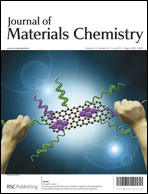Single step aqueous synthesis of pure rare earth nanoparticles in biocompatible polymer matrices†
Abstract
The room temperature synthesis of water soluble, stable rare earth (RE) metal nanoparticles (MNPs) with controlled size is a long standing interest. In the present work, we have established a synthetic strategy for the preparation of pure europium (Eu0) metal nanoparticles (NPs) in aqueous solution employing a γ-radiolytic reduction technique. Since radiolysis is the cleanest method amongst all other chemical routes, we preferentially choose this technique for the reduction of precursor Eu3+ ions to nanoscale metals in our work. This has been possible as hydrated electrons (e−aq) having a very high reduction potential (E0(H2O/e−aq) = −2.87 VNHE) produced in situ can efficiently reduce Eu3+ to Eu0. Synthesized Eu0 MNPs were stabilised within the matrices of biocompatible polymers, polyvinyl alcohol (PVA) and polyvinylpyrrolidone (PVP). Reduction of the metal ion has been conducted at different irradiation doses with a maximum dose of 83.88 kGy. The irradiated solution shows an absorption maximum at 266 ± 2 nm and an emission maximum at 394 ± 5 nm. Analysis of transmission electron microscopy (TEM) images shows that the average sizes of PVA and PVP encapsulated Eu0 NPs are 13 ± 0.6 nm and 17 ± 1.01 nm, respectively ([Eu3+] = 5.0 × 10−3 mol dm−3, [polymer] = 1.0%). Formation of monodisperse pure Eu0 MNPs was further characterised by dynamic light scattering (DLS), energy dispersive X-ray (EDX) as well as Fourier transformed infrared (FTIR) spectroscopy and cyclic voltammetry (CV) studies.


 Please wait while we load your content...
Please wait while we load your content...